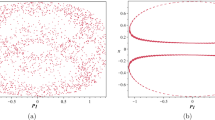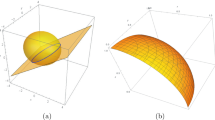Abstract
One of the main problems of astrophysics is to determine the mean field potential of galaxies. The potentials describe the motion in the central region of the galaxy. We can obtain families of star orbits in a galaxy from the astronomical observations. In the present paper, using the tools of the 3D Inverse problem of Dynamics, we study three-dimensional potentials of the form \(V=\mathcal{A}(x^{2}+py^{2}+qz^{2})\), (\(\mathcal{A}\) is an arbitrary function and \(p, \; q=const.\)), which are compatible with a preassigned two-parametric family of spatial regular curves \(f(x,y,z)=c_{1}\), \(g(x,y,z)=c_{2}\) (\(c_{1}, c_{2}=const\)). We establish three differential conditions which are fulfilled by the “slope functions” \(\alpha (x,y,z)\), \(\beta (x,y,z)\) corresponding to the above two-parametric family of orbits. If these conditions are satisfied, then we can find such a potential by quadratures. We offer pertinent examples of potentials which are mainly used in Galactic Dynamics, e.g. axisymmetric potentials, the potential of a homogeneous sphere, potentials coming from power law density profile and potentials which represent the central region of a perturbed triaxial galaxy. Special cases are also examined. Finally, potentials producing families of straight lines are taken into account. Two-dimensional potentials is a special category and it is studied separately.





Similar content being viewed by others
Data Availability
The data that support the findings of this study are available from the corresponding author upon reasonable request.
References
Abouelmagd, E., Guirao, J., Llibre, J.: The dynamics of the relativistic Kepler problem. Results Phys. 19, 1–6 (2020). https://doi.org/10.1016/j.rinp.2020.103406
Alvarez-Ramírez, M., García-Saldaña, J., Medina, M.: Periodic orbits in a three-dimensional galactic potential model via averaging theory. Eur. Phys. J. Plus 135, 787 (2020). https://doi.org/10.1140/epjp/s13360-020-00804-y
Anisiu, M.C.: The energy-free equations of the 3D inverse problem of dynamics. Inverse Probl. Sci. Eng. 13, 545–558 (2005). https://doi.org/10.1080/17415970500170920
Anisiu, M.C., Bozis, G.: Families of orbits in planar anisotropic fields. Astron. Nachr. 326, 75–78 (2005). https://doi.org/10.1002/asna.200410259
Anisiu, M.C., Bozis, G.: Two-dimensional potentials which generate spatial families of orbits. Astron. Nachr. 330, 411–415 (2009). https://doi.org/10.1002/asna.200811035
Anisiu, M.C., Kotoulas, T.: Construction of 3D potentials from a pre-assigned two-parametric family of orbits. Inverse Probl. 22, 2255–2269 (2006). https://doi.org/10.1088/0266-5611/22/6/021
Binney, J.: Resonant excitation of motion perpendicular to galactic planes. Mon. Not. R. Astron. Soc. 196, 455–467 (1981). https://doi.org/10.1093/mnras/196.3.455
Boccaletti, D., Puccaco, G.: Theory of Orbits I: Integrable Systems and Non-perturbative Methods. Springer, Berlin (1996)
Bozis, G.: Determination of autonomous three-dimensional force fields from a two-parameter family of orbits. Celest. Mech. 31, 43–51 (1983). https://doi.org/10.1007/BF01272559
Bozis, G.: Szebehely’s inverse problem for finite symmetrical material concentrations. Astron. Astrophys. 134, 360–364 (1984)
Bozis, G.: The inverse problem of dynamics: basic facts. Inverse Probl. 11, 687–708 (1995). https://doi.org/10.1088/0266-5611/11/4/006
Bozis, G., Grigoriadou, S.: Families of planar orbits generated by homogeneous potentials. Celest. Mech. Dyn. Astron. 57, 461–472 (1993). https://doi.org/10.1007/BF00695715
Bozis, G., Kotoulas, T.: Three-dimensional potentials producing families of straight lines (FSL). Rend. Semin. Fac. Sci. Univ. Cagliari 74, 83–99 (2004)
Bozis, G., Kotoulas, T.: Homogeneous two-parametric families of orbits in three-dimensional potentials. Inverse Probl. 21, 343–356 (2005). https://doi.org/10.1088/0266-5611/21/1/021
Bozis, G., Nakhla, A.: Solution of the three-dimensional inverse problem. Celest. Mech. 38, 357–375 (1986). https://doi.org/10.1007/BF01238926
Bozis, G., Caranicolas, N.: Potentials creating subfamilies of Keplerian ellipses. In: Asteriades, G., et al. (eds.) The Earth and the Universe, pp. 245–252. Ziti Editions, Thessaloniki (1997)
Cao, S., Biesiada, M., Yao, M., Zhu, Z.H.: Limits on the power-law mass and luminosity density profiles of elliptical galaxies from gravitational lensing systems. Mon. Not. R. Astron. Soc. 461, 2192–2199 (2016). https://doi.org/10.1093/mnras/stw932
Caranicolas, N.: Potentials for the central parts of a barred galaxy. Astron. Astrophys. 332, 88–92 (1998)
Caranicolas, N.: Exact periodic orbits and chaos in polynomial potentials. Astrophys. Space Sci. 271, 341–352 (2000)
Caranicolas, N., Barbanis, B.: Periodic orbits in nearly axisymmetric stellar systems. Astron. Astrophys. 114, 360–366 (1982)
Caranicolas, N., Karanis, G.: Chaos in barred galaxy models. Astrophys. Space Sci. 259, 45–56 (1998)
Caranicolas, N., Zotos, E.: Using the S(c) spectrum to distinguish between order and chaos in a 3D galactic potential. New Astron. 15, 427–432 (2010)
Contopoulos, G.: A third integral of motion in a galaxy. Z. Astrophys. 49, 273–291 (1960)
Contopoulos, G., Barbanis, B.: Resonant systems with three degrees of freedom. Astron. Astrophys. 153, 44–54 (1985)
Contopoulos, G., Magnenat, P.: Simple three-dimensional periodic orbits in a galactic-type potential. Celest. Mech. 37, 387–414 (1985). https://doi.org/10.1007/BF01261627
Kirk, S., Haranas, I., Gkigkitzis, I.: Satellite motion in a Manev potential with drag. Astrophys. Space Sci. 344, 313–320 (2013). https://doi.org/10.1007/s10509-012-1330-0
Koopmans, L.: Gravitational lensing and stellar dynamics. In: Mamon, G., Combes, F., Deffayet, C., Fort, B. (eds.) Mass Profiles and Shapes of Cosmological Structures. EAS Publications Series, pp. 1–6 (2005)
Kotoulas, T., Bozis, G.: Two-parametric families of orbits in axisymmetric potentials. J. Phys. A, Math. Gen. 39, 9223–9230 (2006). https://doi.org/10.1088/0305-4470/39/29/015
Kuzmin, G.G., Veltmann, U.I.: Density projections and generalized isochronic models of spherical stellar systems. Publ. Tartu Astrofiz. Obs. 40, 281–303 (1973)
Navarro, J., Frenk, C., White, S.: A universal density profile from hierarchical clustering. Astrophys. J. 490, 493–508 (1997). https://doi.org/10.1086/304888
Patsis, P., Katsanikas, M.: The phase space of boxy–peanut and X-shaped bulges in galaxies – I. Properties of non-periodic orbits. Mon. Not. R. Astron. Soc. 445, 3525–3545 (2014a). https://doi.org/10.1093/mnras/stu1988
Patsis, P., Katsanikas, M.: The phase space of boxy–peanut and X-shaped bulges in galaxies – II. The relation between face-on and edge-on boxiness. Mon. Not. R. Astron. Soc. 445, 3546–3556 (2014b). https://doi.org/10.1093/mnras/stu1970
Plummer, H.: On the problem of distribution in globular star clusters. Mon. Not. R. Astron. Soc. 71, 460–470 (1911). https://doi.org/10.1093/mnras/71.5.460
Pucacco, G.: Resonances and bifurcations in axisymmetric scale-free potentials. Mon. Not. R. Astron. Soc. 399, 340–348 (2009). https://doi.org/10.1111/j.1365-2966.2009.15284.x
Puel, F.: Explicit solutions of the three dimensional inverse problem of dynamics using the Frenet reference system. Celest. Mech. Dyn. Astron. 53, 207–218 (1992). https://doi.org/10.1007/BF00052609
Sarlet, W., Mestdag, T., Prince, G.: A generalization of Szebehely’s inverse problem of dynamics in dimension three. Rep. Math. Phys. 79, 367–389 (2017). https://doi.org/10.1016/S0034-4877(17)30049-6
Shorokhov, S.: Solution of an inverse problem of the dynamics of a particle. Celest. Mech. 44, 193–206 (1988). https://doi.org/10.1007/BF01230715
Skokos, C., Patsis, P., Athanasoula, E.: Orbital dynamics of three-dimensional bars - I. The backbone of three-dimensional bars. A fiducial case. Mon. Not. R. Astron. Soc. 333, 847–860 (2002). https://doi.org/10.1046/j.1365-8711.1999.02964.x
Szebehely, V.: On the determination of the potential by satellite observations. In: Proc. of the International Meeting on Earth’s Rotation by Satellite Observation, pp. 31–35. The University of Cagliari, Bologna (1974)
Szebehely, V., Lundberg, J., McGahee, W.: Potential in the central bar structure. Astrophys. J. 239, 880–881 (1980). https://doi.org/10.1086/158173
Váradi, F., Érdi, B.: Existence of the solution of Szebehely’s equation in three dimensions using a two-parametric family of orbits. Celest. Mech. 30, 395–405 (1983). https://doi.org/10.1007/BF01375509
Wilkinson, M., Evans, N.: The present and future mass of the milky way halo. Mon. Not. R. Astron. Soc. 310, 645–662 (1999). https://doi.org/10.1046/j.1365-8711.1999.02964.x
Zotos, E., Caranicolas, N.: Determining the type of orbits in the central region of barred galaxies. Res. Astron. Astrophys. 16, 26 (2016)
Acknowledgements
I would like to thank the Reviewer for his valuable comments which improved the first version of this manuscript. Also, many thanks to Prof. G. Bozis for very useful discussions.
Funding
There were no funds for this work to the author Thomas Kotoulas.
Author information
Authors and Affiliations
Contributions
The present work in this paper is totally carried out by the author: Thomas Kotoulas. He wrote the manuscript, derived the equations, carried out the computations using the symbolic algebra program MATHEMATICA 11.0, solved the problem analytically, produced results and verified them.
Corresponding author
Ethics declarations
Conflict of Interest
The author declares that he has no conflict of interest.
Additional information
Publisher’s Note
Springer Nature remains neutral with regard to jurisdictional claims in published maps and institutional affiliations.
Rights and permissions
About this article
Cite this article
Kotoulas, T. Two-parametric families of orbits created by three-dimensional galactic-type potentials. Astrophys Space Sci 367, 69 (2022). https://doi.org/10.1007/s10509-022-04096-9
Received:
Accepted:
Published:
DOI: https://doi.org/10.1007/s10509-022-04096-9




